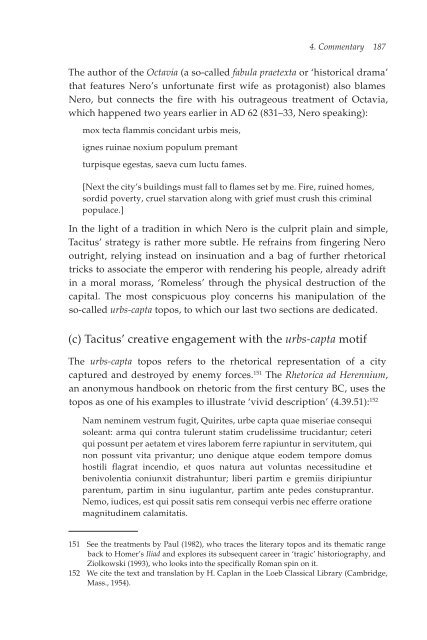Tacitus, Annals, 15.20-23, 33-45. Latin Text, Study Aids with Vocabulary, and Commentary, 2013a
Tacitus, Annals, 15.20-23, 33-45. Latin Text, Study Aids with Vocabulary, and Commentary, 2013a
Tacitus, Annals, 15.20-23, 33-45. Latin Text, Study Aids with Vocabulary, and Commentary, 2013a
Create successful ePaper yourself
Turn your PDF publications into a flip-book with our unique Google optimized e-Paper software.
The author of the Octavia (a so-called fabula praetexta or ‘historical drama’<br />
that features Nero’s unfortunate first wife as protagonist) also blames<br />
Nero, but connects the fire <strong>with</strong> his outrageous treatment of Octavia,<br />
which happened two years earlier in AD 62 (831–33, Nero speaking):<br />
mox tecta flammis concidant urbis meis,<br />
ignes ruinae noxium populum premant<br />
turpisque egestas, saeva cum luctu fames.<br />
[Next the city’s buildings must fall to flames set by me. Fire, ruined homes,<br />
sordid poverty, cruel starvation along <strong>with</strong> grief must crush this criminal<br />
populace.]<br />
In the light of a tradition in which Nero is the culprit plain <strong>and</strong> simple,<br />
<strong>Tacitus</strong>’ strategy is rather more subtle. He refrains from fingering Nero<br />
outright, relying instead on insinuation <strong>and</strong> a bag of further rhetorical<br />
tricks to associate the emperor <strong>with</strong> rendering his people, already adrift<br />
in a moral morass, ‘Romeless’ through the physical destruction of the<br />
capital. The most conspicuous ploy concerns his manipulation of the<br />
so-called urbs-capta topos, to which our last two sections are dedicated.<br />
(c) <strong>Tacitus</strong>’ creative engagement <strong>with</strong> the urbs-capta motif<br />
The urbs-capta topos refers to the rhetorical representation of a city<br />
captured <strong>and</strong> destroyed by enemy forces. 151 The Rhetorica ad Herennium,<br />
an anonymous h<strong>and</strong>book on rhetoric from the first century BC, uses the<br />
topos as one of his examples to illustrate ‘vivid description’ (4.39.51): 152<br />
Nam neminem vestrum fugit, Quirites, urbe capta quae miseriae consequi<br />
soleant: arma qui contra tulerunt statim crudelissime trucidantur; ceteri<br />
qui possunt per aetatem et vires laborem ferre rapiuntur in servitutem, qui<br />
non possunt vita privantur; uno denique atque eodem tempore domus<br />
hostili flagrat incendio, et quos natura aut voluntas necessitudine et<br />
benivolentia coniunxit distrahuntur; liberi partim e gremiis diripiuntur<br />
parentum, partim in sinu iugulantur, partim ante pedes constuprantur.<br />
Nemo, iudices, est qui possit satis rem consequi verbis nec efferre oratione<br />
magnitudinem calamitatis.<br />
151 See the treatments by Paul (1982), who traces the literary topos <strong>and</strong> its thematic range<br />
back to Homer’s Iliad <strong>and</strong> explores its subsequent career in ‘tragic’ historiography, <strong>and</strong><br />
Ziolkowski (1993), who looks into the specifically Roman spin on it.<br />
152 We cite the text <strong>and</strong> translation by H. Caplan in the Loeb Classical Library (Cambridge,<br />
Mass., 1954).


















